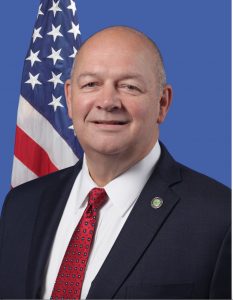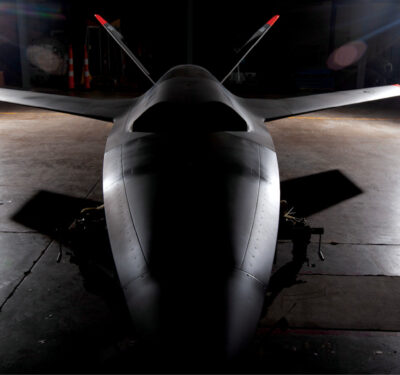
New Administrator of the Federal Aviation Administration Stephen Dickson. Photo: FAA.
Victory! We finally have a former Airman appointed Administrator of the Federal Aviation Administration. And not just any Airman; Stephen Dickson is an Air Force Academy grad AND a former F-15 pilot. Although I never served in an F-15 squadron, I do know a few phrases in F-15. The key one for Administrator Dickson’s tenure is: “I shot you BVR, so I ignored you post merge.” F-15 pilots use this phrase during Red Flag exercise debriefs when it is obvious an F-16 has just gunned them to death after a mock dogfight. The F-15 is designed to use its massive radar and long-range missiles to shoot down enemy fighters beyond visual range (BVR) and avoid close-in dogfights. Hence, the F-15 pilot was saying that F-16 couldn’t have shot him down because he had killed him down long before the F-16 “merged” into a dogfight with his Eagle. Dead men kill no Eagles.
So, I’ll ask our new Administrator to remember his air combat experience as he reads this letter. After all, it’s a lot easier to shoot down problems BVR before they close to gun range.
Dear Administrator Dickson,
I know you have a lot of big problems to solve in the FAA. The Boeing 737 Max, air traffic privatization and keeping Next Gen on track are all huge issues, but I’ll concentrate on an issue that impacts all these issues—drones. I know some folks think of drones separately from manned aviation, and you have some staffers trying to keep it that way. But drones will impact airworthiness procedures more than the Max does, might just privatize air traffic management by automating it and will probably add a whole new generation to Next Gen. I’ve spoken to some thought leaders in the drone world and here’s their advice:
Words from the Wise
Use research better: ASSURE, your unmanned center of excellence, has done a great job with its tasks. Its drone air and ground collision work are world firsts. However, it takes forever to clear research tasks through your staff/DOT to get ASSURE working, and ASSURE can help much more with some of your big problems, like remote ID, training/airworthiness standards and C2 spectrum. Cybersecurity for autonomy is a crucial area that you can get ASSURE working on now.
Your Test Center in New Jersey is also underutilized. It’s doing great work, but it’s mostly for manned aviation. Research is your long-range radar; you can’t fight BVR if your researchers aren’t looking at issues before they become problems. Also, please make sure you use research to write rules. Believe it or not, the FAA’s proposed Operations of Small UAS Over People rules came out two months before ASSURE’s ground collision research finished. Guess what? The research showed the draft rules were off by an order of magnitude. That research radar is no good if you ignore the tracks.
Stop asking for rocks: A big reason why you’re always in a dogfight over drones is the FAA’s “bring me a rock” syndrome. The FAA is infamous for asking industry for solutions and then telling them they aren’t acceptable without telling them why. (“Bring me a rock. No, not that rock; a different one.”) Optimists say that’s because the FAA doesn’t want to dictate solutions to industry. Pessimists say it’s because the bureaucrats don’t want the responsibility of owning the solution.
“Bringing rocks” might work for well-known manned aviation issues, such as runway congestion or approach separation. It won’t work where there aren’t existing rules or manned aviation analogues to go by. Recommend doing things the NASA way. Invite a lot of people to write your concept of operations (CONOPS), give a lot of feedback as they write it, hand the hard part over to researchers and leave no doubt in stakeholders’ minds as to why their idea was brilliant—or stupid. Your folks tend to ask MITRE to write concepts of operation, staff them internally and then release them for comment. You’re almost guaranteed to be wrong with that approach.
A great place to start fixing this is with Part 107 waivers. Get some straight stats from the staff. Don’t ask how many waivers they’ve approved; ask how many they’ve turned down. For example, the approval stats for drone night ops are great, but terrible for beyond visual line of sight (BVLOS) and operations over people. Ask how anyone can have a more than 90% waiver turndown rate for BVLOS operations. Congress told the FAA to start giving feedback on all waiver refusals and that’s a great idea. When you turn down 90% of waivers, it’s not the writer’s fault; a feedback loop is broken somewhere. The Red Flag mission debrief is a main reason we’ve never lost an F-15 in air to air combat. In Air Force debriefs, the rank comes off and the truth comes out. If there is a tactics problem, no one leaves until everyone agrees the problem is solved. Ask why we can’t do Red Flag waiver debriefs and tell everyone how to get better.
Beware the triad: This triad isn’t a Chinese crime gang; it’s an attempt by the Communist Chinese to take over drone traffic management and remote ID in the United States. Communist Chinese companies own more than 80% of the US consumer/prosumer drone airframe market and are using this position to take over the other two legs of the triad—unmanned traffic management and remote ID. I can remember back in the early days of Next Gen when the FAA tried to keep Thales from Next Gen air traffic management. I don’t know what happened between trying to keep our oldest ally from air traffic management and essentially welcoming Communist China into it, but you should stop it. The CIA can brief you on the Communist Chinese plan to dominate key tech sectors. NSA has a great demo on what an adversary can do if they make the chips, firmware and software. It’s sobering.
Now, some of your folks think the FAA does safety, not security, and it isn’t your place to act against a hostile country. Others think the Chinese position is so dominating that it will set back US drone progress if we kick them out of UTM and remote ID. I think we get what we regulate. Want a safe and secure UTM? Write security into UTM and remote ID rules. Security must be “baked in” at the design phase to be effective, so you must work quickly. You have an Executive Order from President Trump that gives you all the cover you need to act on keeping hostile nations out of our networks. American and Allied country industry will fill the void left by the ChiComs in a heartbeat. Just like flying fighters, if the intel bubbas and electronic countermeasures wizards don’t do their work years before you step to the jet, you can’t trust what your sensors tell you. It’s the same with the People’s Republic being in our traffic management systems.
UTM will take over the earth: No one has fielded a fully automated air traffic management system yet, but UTM will work and it will be automated. Right now, your staff is letting industry lead UTM development. That’s a great idea, but beware “retro rocks” when something goes wrong. Some joke about the FAA being a “Tombstone Agency” that only makes major changes after a big accident. The Boeing 737 Max is one of those retro rocks—“Did we let Boeing self-certify those massive changes? Wrong rock, Boeing!”
What to Do?
Recommend you set expectations for industry early with UTM. It shouldn’t be a Wild West system with UTM companies setting their own security standards and airspace procedures—possibly even carving up airspace among themselves.
Recommend that even though the FAA won’t own the UTM infrastructure, you will set standards and ensure they’re enforced.
Recommend you start with security. Keep in mind, UTM will be the beginnings of a truly privatized system. An automated UTM system will work great and pressure will start immediately to apply it to manned aircraft. Make sure you’re ready for that. I understand the “AWACS vs. fighter pilot” battle over who’s really in control of the fight. America dominates the air because we let our fighter pilots (or UTM industry) aggressively seek out our enemies. Keep in mind, we had a 4:1 kill ratio in Vietnam before we had AWACS (FAA oversight). We haven’t had a kill ratio since AWACS because we haven’t lost a USAF jet in air to air combat after AWACS. A bit of centralized control is good.
It’s the data link, stupid: Sorry about the title, but command and control (C2) for BVLOS is a mid-air waiting to happen. EVERYONE one wants BVLOS but no one is thinking about the C2. The Air Force makes BVLOS look easy because it can afford SATCOM and has plenty of military bandwidth to use. But once you subtract military bandwidth and cell phone spectrum, there ain’t much spectrum left for commercial drone C2. Data links are the biggest difference between drones and manned aircraft. Drone links must be fast, secure and ultra-reliable. That requires spectrum, and flight critical functions require aviation protected spectrum. The best way around unreliable links is full autonomy, but that’s another area your staff hasn’t begun to address yet. BVLOS links/autonomy are a great problem to turn over to your research folks and convene one of those big NASA-style CONOPS conventions. Air-to-air guys learned to stay way ahead of the jet and lead their targets before we even had jets. This is a great problem for that principle.
Quick Kills:
Here are some (sorta) easy ones that you can knock down quickly to get your kill count up:
Remote ID: I’ve heard that the draft rules went to the Office of Management and Budget and the rules require all drones over 250 grams to have remote ID. That’s great! Everyone must have remote ID or we’ll never be able to tell hobbyist from terrorist. ASTM International has already produced a great remote ID standard for you. Remote ID standards and rules will really move the industry forward and make us all much safer if you can get the rules out quickly.
Operations Over People: The FAA draft Operations of Small UAS Over People was a swing and a miss. You can easily fix it by getting with your ASSURE team to get the ground impact numbers correct and by removing the prohibition on small drone flight over moving vehicles. The rest of the rule is pretty good.
Large UAS in the National Airspace: We had great aviation rulemaking committee meeting on this subject and everyone (even the Air Traffic folks) agreed to use modified USAF procedures for flying drones over 55 pounds in controlled airspace. That was two years ago and your staff has gone NORDO on large drones since. Can we see some draft rules, please?
Counter Drone: Congress gave you a lot of guidance on counter-drone operations. Recommend you move quickly on it. Congress told you to do a Counter-UAS ARC, but how about a big “open tent” counter-UAS CONOPS meeting first? Feds can’t participate in ARCs and both you and industry need to know what the Department of Defense, Department of Homeland Security and Intelligence Community think as you write a CONOPS. Ask close allies with big counter-drone problems (Brits and Israelis) to come. It’s a tough problem and it could bite you on Day One—just ask the tower at Gatwick. Also, Congress also told our airports they could use the Airport Improvement Program to buy counter-drone gear. I’d help them buy gear now, even if it isn’t the 100 percent solution yet.
Sensible Automation
I know civilian drones are a mess right now and some on your staff see them as an unfunded mandate with tough problems the FAA isn’t equipped to handle. However, that attitude took us out of the BVR fight and put the FAA in a series of dogfights it could have avoided if it was proactive. It’s popular to talk about getting government out of the way of industry, but this is one industry that won’t progress without your rules. Automation, autonomy and drones in general are a big cultural challenge for your staff, but it’s one we conquered in the Air Force. Remember the massive debate about single-seat fighters back when we joined the Air Force? I know you probably got a lot of flak from the old F-4 guys about “single-pilot saturation” when operating a fast jet with a complex radar. Sensible automation worked out fine for the F-15.
I was at Bergstrom AFB, TX, for my first assignment with the RF-4C recce jet. Drones replaced those two-crew jets decades ago and we wouldn’t have wiped the floor with Al Qaeda without drones. After a long cultural fight similar to the one the FAA is going through now, the Air Force accepted drones. Heck, they’ve trained more drone pilots than bomber or fighter pilots combined for years now. A single drone squadron at Creech AFB routinely flies more hours annually than all the fighter squadrons in PACAF (Pacific Air Forces). Automation, autonomy and drones are the future, and you can do a lot on your watch to make that future happen safely, securely and profitably!
With Respect,
James Poss, Fellow Air Force Vet






